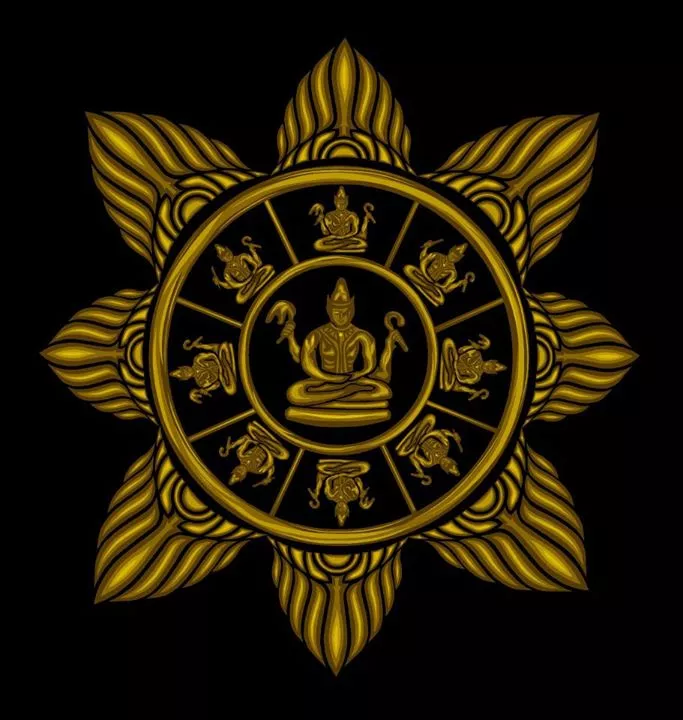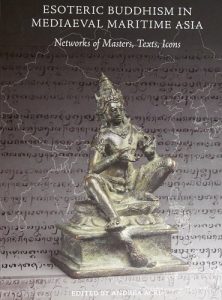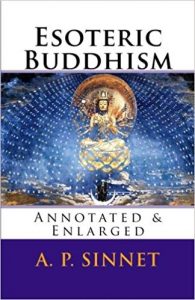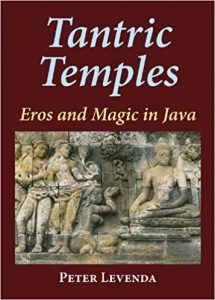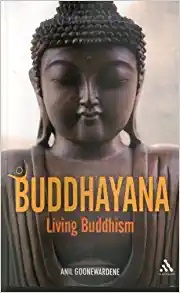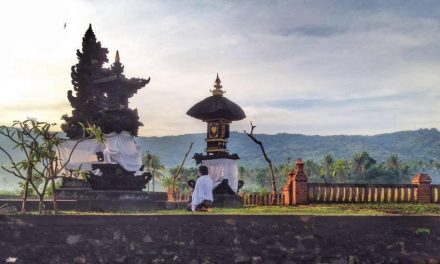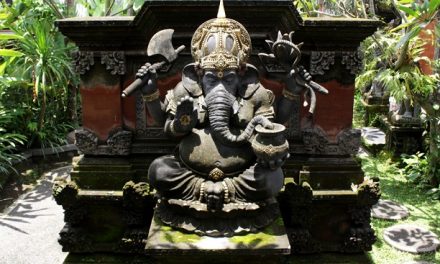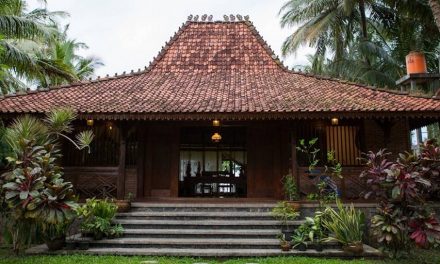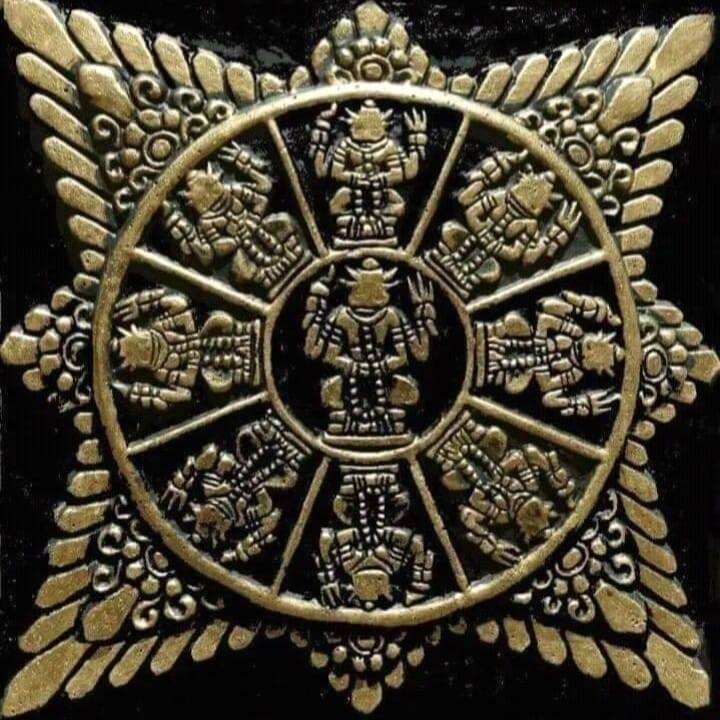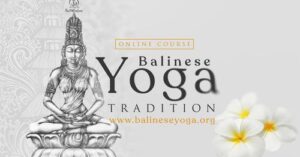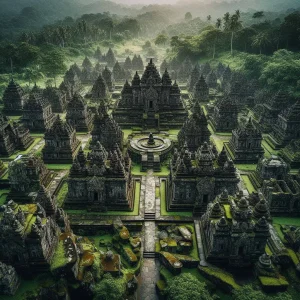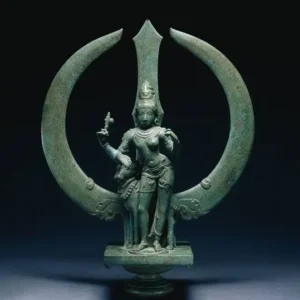Maha Vihara Mojopahit in Trowulan
Indonesian Esoteric Buddhism (Vajrayāna, Mantrayāna or Tantrayāna) emerged along the maritime trade routes and port cities of Java, Sumatra and Malaysia. This tradition was also linked with Indian Vajrayana, Tantric Buddhism in Sinhala, Cham, Cambodia and all the way to China and Japan.
It is hard to separate them completely and it is better to speak of a complex of “Esoteric Buddhism of Maritime Asia.” In many of the key South Asian port cities that saw the growth of Esoteric Buddhism, the tradition coexisted alongside Shaivism.
Buddhism in Indonesia decreased with the fall of Majapahit because of the civil war that saw the appearance of the Mohammedans. By that time, the Javanese Buddhists started to resorb within Kejawen, the original Javanese ascetic religion.
Pockets of original Javanese Buddhists still exist in Central and East Java. The regencies of Temanggung, Blitar and Jepara count about 30.000 Javanese Buddhists. Indonesian Esoteric Buddhism is also experiencing a revival among the educated classes in Jakarta and Surabaya.
☸ Javanese masters of Esoteric Buddhism
• The diffusion of Esoteric Buddhism in the region began with the arrival of Buddhist monks in the 7th century, such as the Chinese Yijing or the Indians Dharmaruci and Vajrabodhi.
• The oldest Esoteric Buddhist literature in Old Javanese is the Sang Hyan Kamahayanikan, which describes teachings coming from Dignāga. The Saṇ Hyaṇ Kamahāyānikan was critical in the development of Indonesian Esoteric Buddhism.
• Another work by an Indonesian Tantric Buddhist is Bianhong’s Ritual Manual for Initiation into the Great Mandala of the Usnisa-Cakravartin which also survives in the Chinese Taisho Tripitaka. Binahong was the guru of Kūkai, the monk who brought Buddhism to Japan.
• The Tibetan Buddhist canon includes many translations of texts written by Javanese masters, such as the Durbodhaloka (a commentary on the Abhisamayalamkara) of Dharmakīrti, a revered Srivijayan Buddhist scholar. He built on and reinterpreted the work of Dignāga, the pioneer of Buddhist Logic. His theories became normative in Tibet and are studied to this day.
• The Chinese monk Yijing translated of a large numbers of Indonesian Buddhist scriptures from Sanskrit into Chinese. He translated more than 60 sutras into Chinese such as the Golden Light sūtra.
His Record of Buddhist Practices Sent Home from the Southern Sea is a fantastic travel diary, describing his adventurous journey to Srivijaya and India and the lifestyles of various local peoples.
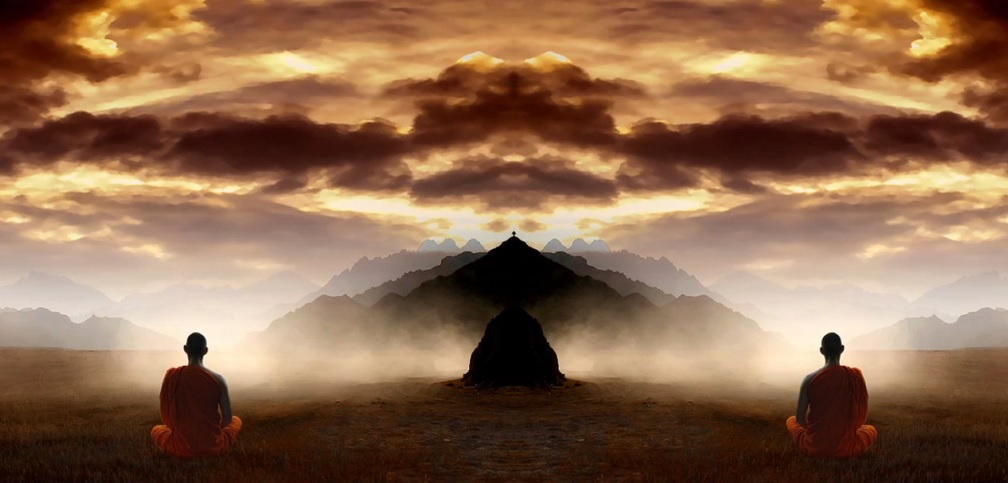
☸ Timeline of Buddhism in Indonesia
• Buddhism in Java and Sumatra was originally developed by the Theravada monk Gunawarman. In 421 AD he came to Java and translated scriptures that later formed the Mulasarvastivada lineage.
• The monk Hui Neng lived for three years in Kalingga, translating various Buddhist scriptures with the help of the Javanese monk Jnanabhadra. They translated, among others scriptures, the Mahaparinibbana Sutta.
• Amoghavajra and his master, Vajrabodhi were both patriarchs of the Mantrayana school and disembarked in Java in the first half of the 8th century AD.
• The Kalurak inscription (782) relates the inauguration of a statue of Manjusri. It mentions that Manjusri was likened to the Triratna (Triple Gem) and is also identified with the Trimurti, making it the first appearance of what would later become the Indonesian Shiva-Buddha religion.
• The Sailendra dynasty then embraced Buddhism, as seen in the foundation of Kalasan Temple which is dedicated to the goddess Ārya Tārā (Prajnaparamita in Esoteric Buddhism).

Javanese Buddha in gold, 33,7 cm, 11th century
☸ A Pan-Asian Network of Buddhist Masters
Researcher Andrea Acri demonstrated in a groundbreaking book called Esoteric Buddhism in Mediaeval Maritime Asia: Networks of Masters, Texts, Icons how from the early 7th century, Esoteric Buddhist masters, texts, and icons traveled far and wide across Asia in a circular manner through multiple centers of diffusion.
Traders, Buddhist monks, and Shaivite Brahmans spread art, architecture and material culture all over Dvipantara (Southeast Asia). The book lays emphasis on the mobile networks of human agents (‘Masters’), textual sources (‘Texts’) and images (‘Icons’) through which Esoteric Buddhist traditions spread.
The Buddhist and Hindu kingdoms all over Southeast Asia acted as crossroads of political power, mercantile entrepreneurship, and centers of learning, worship, and pilgrimage where esoteric forms of Hinduism and Buddhism coexisted.
In this book, he makes an argument for the important role played by regions such as Sri Lanka, Tamil Nadu, Odisha, Malaysia and Indonesia in the genesis and propagation of Esoteric Buddhist lineages, scriptures and art across Asia. The book is divided into three thematic sections on (1) monks, texts, patrons, (2) art, architecture, and material culture, and (3) Buddha-Shaiva dynamics.
Andrea Acri’s research provides a treasure trove of detail on the ‘networks of masters, texts and icons’ of Esoteric Buddhism that united monastic, dynastic and lay practitioners in a vast geographical zone that stretched from South Asia through Southeast Asia to China, Korea and Japan.
This book overturns the popular perception regarding Southeast Asia as a periphery that ‘passively’ received overseas influences. It demonstrates how the region was both a crossroads and terminus of Buddhist lineages. The book also draws our attention to the links between the kingdom of Srivijaya and Tibet, studied through the life of the monk Atisha.
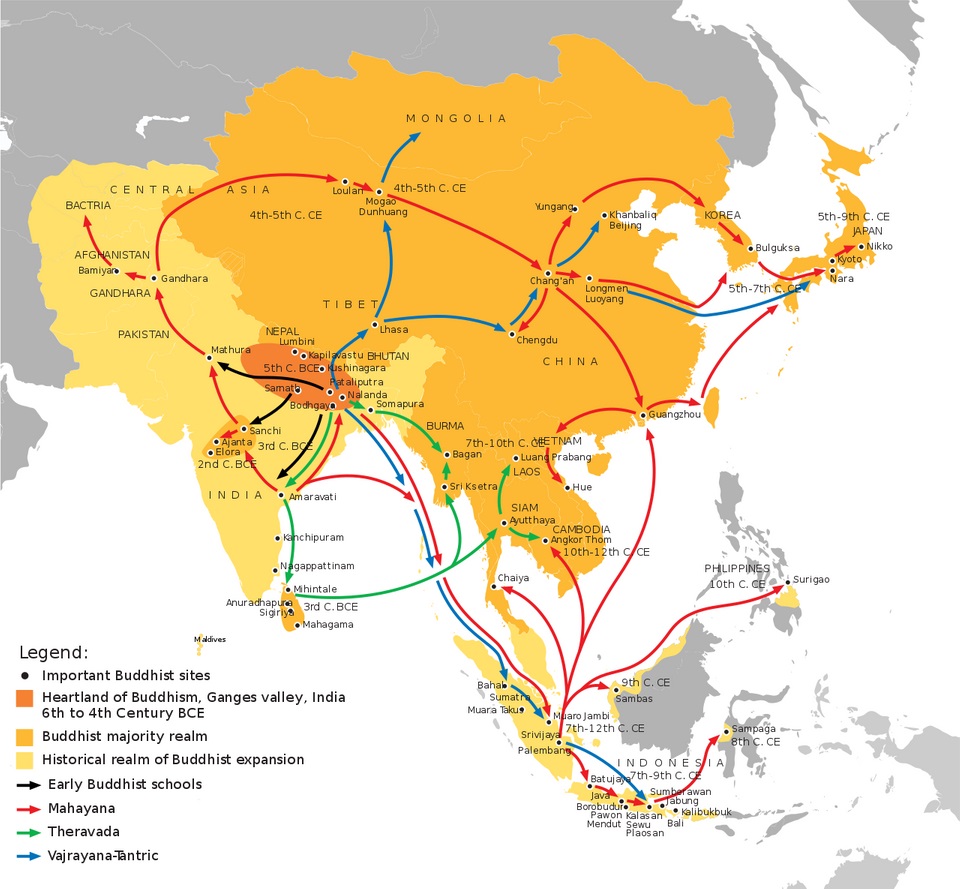
☸ Esoteric Buddhism in the Indonesian Kingdoms
Sriwijaya
The kingdom of Śrīvijaya, located near the current city of Palembang in Sumatra, was for many centuries a prominent international center in the Buddhist world. A stronghold of Esoteric Buddhism, the Srivijaya empire patronized Buddhist monks and institutions and attracted pilgrims and scholars from all parts of Asia.
These included Yi Jing, who made several long visits to Sumatra on his way to study at Nalanda University in India, and the Buddhist scholar Atisha who played a major role in the development of Vajrayana Buddhism in Indonesia and Tibet. Atisha lived in Sumatra from 1011 to 1023. He studied under the guidance of Dharmakirti, a leading monk of Srivijaya.
Yijing praised the high level of Buddhist scholarship in Srivijaya and advised Chinese monks to study there prior to making the journey to Nalanda in India. Monks from India also did travel to the famous Śrīvijaya.
For instance, we read in Tāranātha‘s History of Buddhism in India that, after his retirement from Nālandā University, the wise Dharmapāla left for Sumatra to stay there for the rest of his life. He is said to have gained immortality (amṛtasiddhi) there, never to be reborn again.
Sriwijaya expanded its dominion into Southern Thailand – Suratani and Pattani. The temples made by Srivijaya there, such as Vihara Mahadhatu in Jaiya and Vihara Mahadhatu in Nakorn si Thamarat still exist until now. The Buddhist statues there are in Javanese style.
Today, not much remains of the temples in Sumatra, except the Muaro Jambi temple, Muara Takus temple (in Riau) and the Gunung Tua temple.
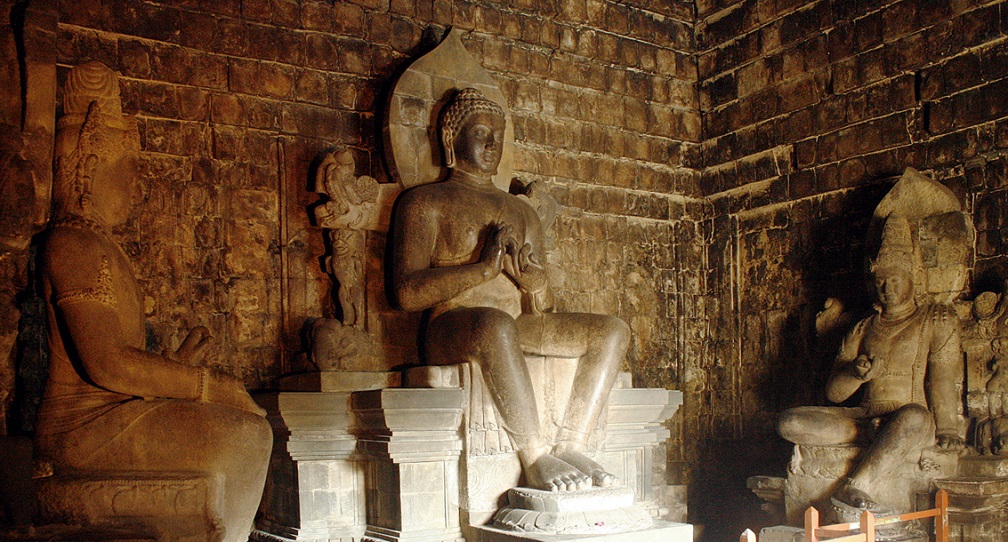
Dhyani Buddha Vairocana, Avalokitesvara, and Vajrapani inside the Mendut temple
Kalingga
The Kalingga Kingdom was one of the first Hindu-Buddhist kingdoms in Central Java, located between present-day Pekalongan and Jepara. The kingdom was described as being surrounded by wooden fortresses, with the King residing in a multiple storied palace covered with a roof made of the leaves of Arengga pinata trees. The kingdom exported silver, gold and elephant tusks.
The Kalingga kingdom was very orderly and serene, and led by Queen Sima. It was a center of Buddhist studies and practice, and the Chinese came to Kalingga to study Buddhism., which around that time became the official religion in China. Two temples remain from the Kalingga Kingdom: Candi Angin and Candi Bubrah in Tempur Village, the present day Jepara.
The great Manjusrigrha Templeof Medang
The Buddhist king Panangkaran who ruled the Medang Kingdom started the construction of the great Manjusrigrha Temple (‘House of Manjushri‘, the Bodhisattva of Wisdom), which is the original name of the Sewu Temple complex, the second largest Buddhist complex in Indonesia after Borobudur, with 249 buildings.
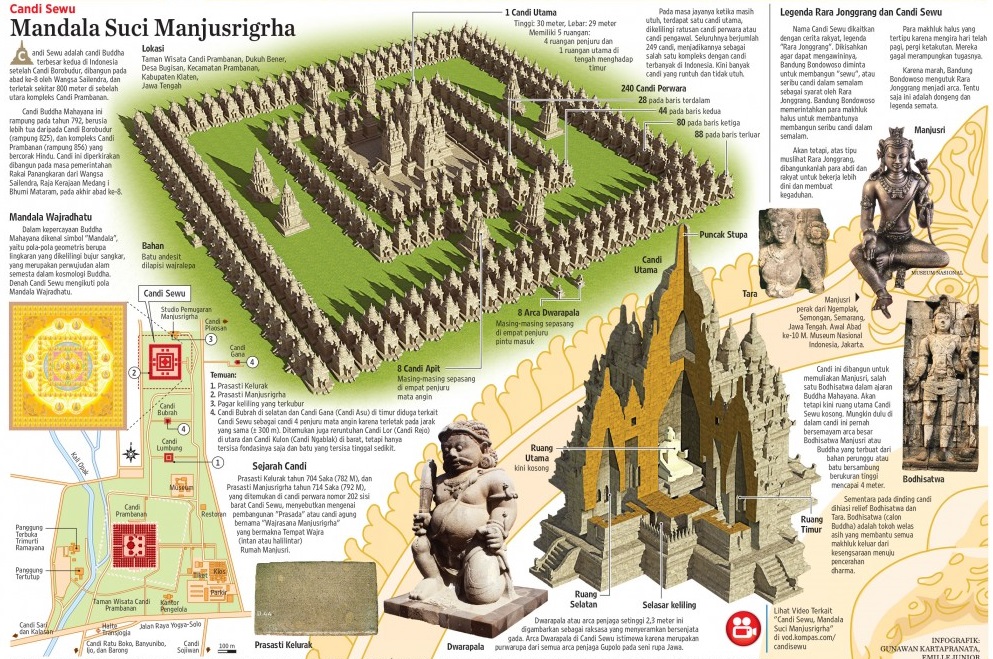
An important gold artefact was recovered from the Ratu Boko temple near Prambanan. The inscribed gold foil consisting of two connected diamond-shaped leaves recalling a vajra, bears the Sanskrit mantra oṁ ṭakī hūṁ jaḥ svāhā repeated on each of its four sides.
Singhasari and Majapahit
Java under the Sailendras became a major center of Buddhism, with monumental architecture such as Borobudur and Candi Sukuh. The largest Buddhist stupa in the world is the Borobudur temple in central Java, built as a mandala, a giant three-dimensional representation of Esoteric Buddhist cosmology. The temple shows both Indian and Javanese influences. The reliefs depict stories from the Lalitavistara sūtra, Jataka tales and the Gandavyuha sūtra.
In the 13th century, Buddhism thrived in Eastern Java, where King Kertanegara of Singhasari patronized Esoteric Buddhism (Vajrayana). Buddhism continued to thrive under the Majapahit Empire. Some of their kings were Vajrayana practitioners, such as King Adityawarman whose inscriptions state he was “always concentrated on Hevajra“.
☸ World-famous Indonesian Buddhist Art
The oldest Buddhist statue in Indonesia was found in West Sulawesi, at the mouth of the Sampaga river, Sikendeng Village, Mamuj. It represents Dīpankara Buddha, the protective deity in Buddhism. The statue is in the Amarawati style.
Buddhist holy sites in Indonesia include the Kalasan Temple, near Yogjakarta, the Sari Temple, near Kalasan Temple, Borobudur, the Mendut and Pawon temples on the eastern side of Borobudur, the Ngawen temples complex near Muntilan, the Sewu temples complex near Prambanan, the Plaosan temples complex on the Eastern side of the Sewu Temple and a few others.
The classical era of ancient Java also had produces some of the exquisite examples of Buddhist art, such as the statue of Prajnaparamita of Java and that of Buddha Vairochana and Boddhisttva Padmapani and Vajrapani in Mendut temple.
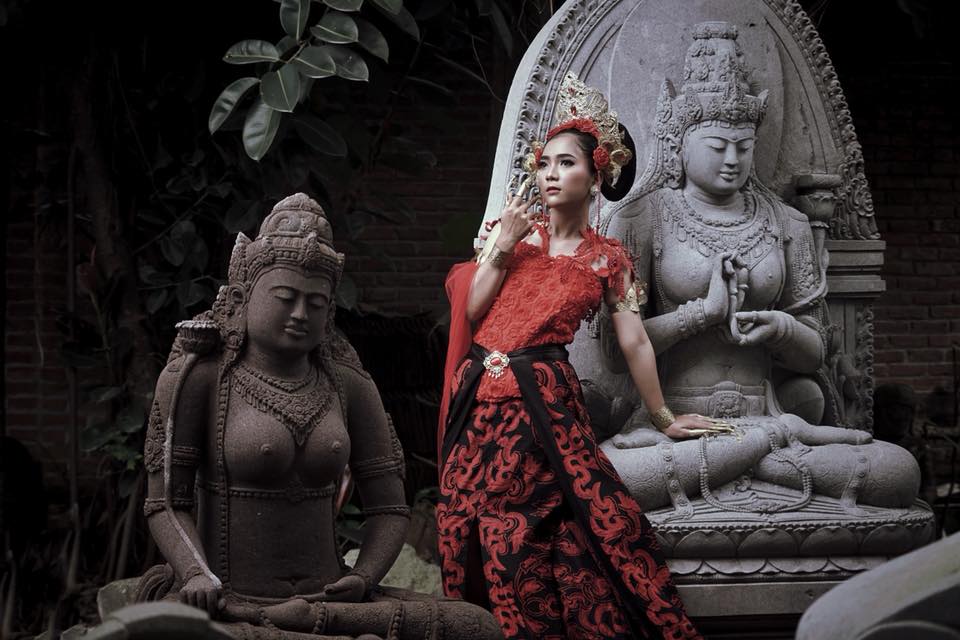
Image source – Didi Trowulanesia
☸ The Shiva-Buddha syncretism
Shaivism was always the dominant religion in Java and Bali. However, Shaivism coexisted alongside Buddhism for more than a millennium and finally merged together, a unique phenomenon in Asia. The variety of “Hinduism” widespread in Java and Bali was fundamentally syncretic in character, forming a blend of Shaivist and Buddhist elements.
During the eras of Kediri, Singhasari and Majapahit empires, Buddhism was acknowledged as one of the kingdom’s official religions along with Hinduism. The harmony, toleration, and even syncretism of Hinduism (Shaivism) and Buddhism were promoted, as manifested in the saying Bhinneka Tunggal Ika, (‘Unity in Diversity’) which later became the national motto of Indonesia, mentioned in the Kakawin Sutasoma
Many other texts from the Hindu-Buddhist kingdoms state that Hinduism and Buddhism are both two paths to the same reality, and also equate the five Buddhas with five forms of Shiva. Likewise, many Majapahit temples depict both Buddhist and Shaivist elements. The most important Buddhist deities that were worshiped included Prajnaparamita (the Goddess of Perfect Knowledge), Tara, Bhairava and Lokesvara.
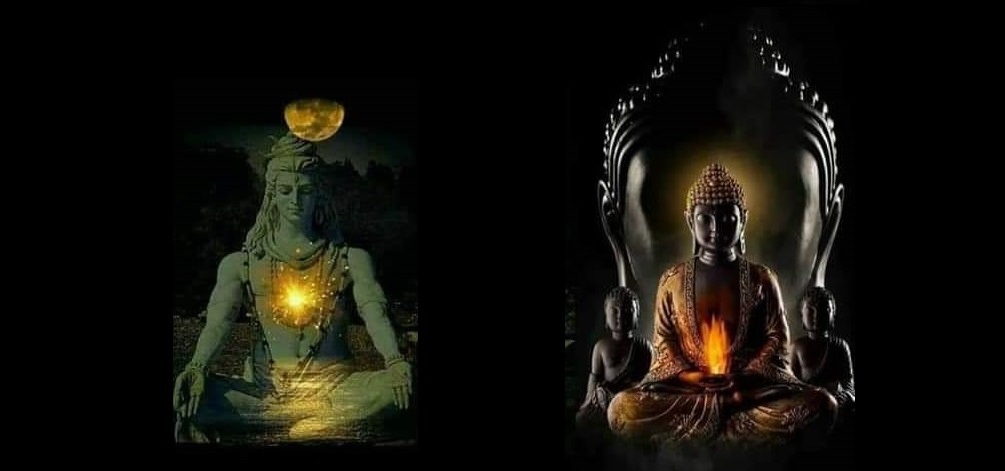
It has been termed the “religion of Śiva-Buddha” or “Hindu-Buddhist religion” (in Indonesian Agama Siwa-Buda or Agama Hindu-Buda). For example, King Vishnuvardhana who died in 1268 was worshiped as a Shiva in the Waleri temple and as Amoghapaça Buddha in the Jago Temple. King Kertanegara was glorified as Shiva and Buddha in the Jawi temple.
• The Sanghyang Kamahayanikan indicates that one can identify Shiva with Buddha and call it ‘Shiva-Buddha’. Both are seen as a form of an assortment of the same truth.
• In the Arjunawijaya it is explained that when the Arjunawijaya entered a Buddhist temple, the monk explained that the Jina of the corners of nature depicted on the sculptures it is tantamount to the incarnation of Shiva.
• In the Kunjarakarna is mentioned that no one, either followers of Shiva and Buddha could have let slip if she separates the real one, namely Shiva-Buddha.
• The Sutasoma states that the Buddha was none other than Brahma-Vishnu-Isvara, the Hindu Trimurti. In fact, Shiva and Buddha is One (Siwa Buddha bhinneka tunggal ika tan hana dharma mangrwa). The Jinatwa (substance of Buddha) is the same as Siwatattwa (substance of Shiva).
Buddhism is generally thought of as non-theistic, but in Indonesia, that non-theistic concept was never really accepted. The Indonesians were accepting the One Supreme Deity, called by different names, and comprehended through various philosophical views.
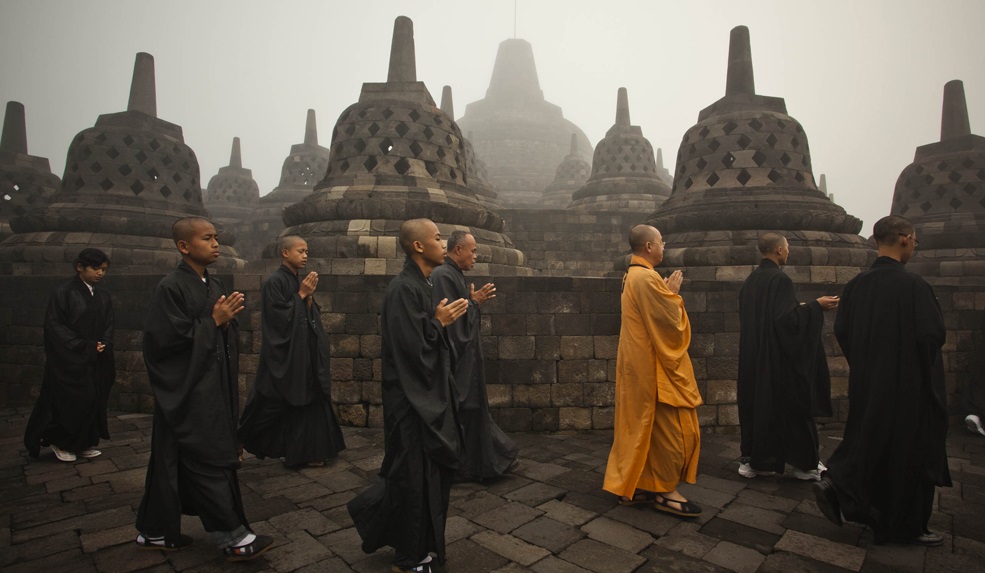
☸ Sanghyang Adi Buddha
In Indonesia, the term Sanghyang Adi Buddha is agreed upon and used by the Indonesian Buddhayana Council as the designation for the God Almighty. This term is not found in the Pāli Canon, but in numerous other scriptures, including Indonesian Mantrayana texts such as the Sanghyang Kamahayanikan.
This term was re-introduced from ancient Indonesian Esoteric Buddhist texts by Ashin Jinarakkhita after independence to reconcile the first principle of the official philosophical foundation of Indonesia (Pancasila), i.e. the “Recognition of the Divine Omnipotence”) that requires the belief in a supreme God.
Sang Hyang Adi-Buddha is the Almighty Primordial Buddha, or Paramādi Buddha (The first and incomparable Buddha). He has some other names such as Adau Buddha (Primordial Buddha) or Uru Buddha (Buddha of the Buddhas).
The concept of Adi Buddha arose from the development of “Theistic Buddhism” which is the last stage of Mahayana Buddhism and mainly influenced by Shaivite (Hindu) views.
Ādi Buddha, or Paramādi Buddha, is a term that came from the Aisvarika and Svabhavavak tradition of Nepal, which spread through Bengal and became later known in Java in the time of Srivijaya and Majapahit. Adi-Buddha is also used in Tibet for the ‘primordial Buddha’, the Buddha without beginning. In traditional Mahayana Buddhism, Adi-Buddha is represented by Mahavairocana Buddha.
Adi Buddha is one of many Buddhist names that may be used for God Almighty, in addition to Advaya, Diwarupa, Mahavairocana (in Kawi Buddhist texts), Vajradhara (in the Tibetan Kagyu and Gelug schools), Samantabhadra (Tibetan Nyingma school) and Adinatha (Nepal).
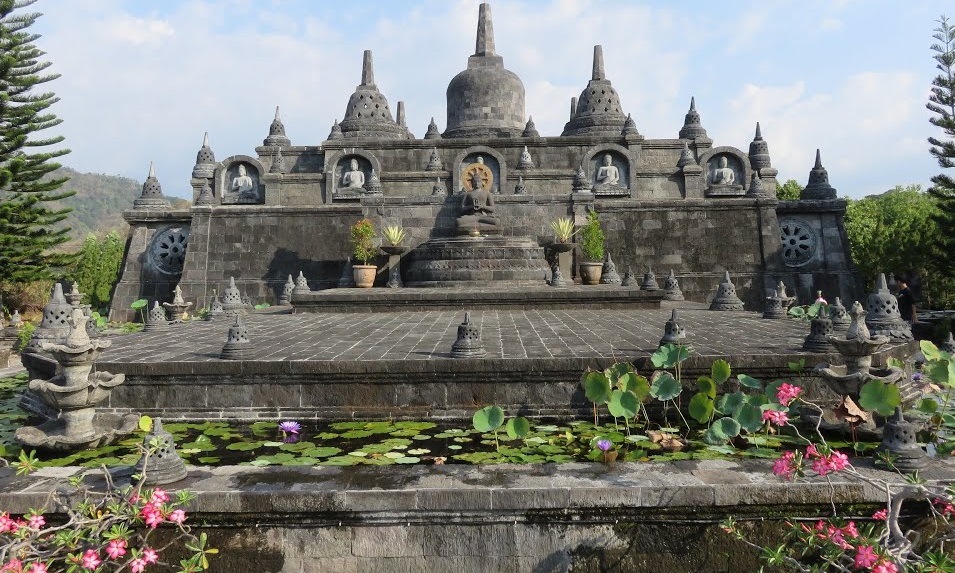
Brahmavihara-Arama Buddhist monastery in Bali – Various unique forms of Buddhist architecture developed in Indonesia and Malaysia the most common of which is the stone Candi which are built as a symbol of Mount Meru. Others were built in punden berundak (step pyramids) style – small terraced sanctuaries built on mountains – and pertapaan, (‘places of austerities’ or hermitages) built on mountain slopes.
In the Indonesian Sanghyang Kamahayanikan, 19th stanza, is explained that the Buddha Gautama was merged with Sang Hyang Adhi Buddha, or in other words that Buddha Gautama was the manifestation of the Adi Buddha.
Sanghyang Adi Buddha is the origin of everything in the Universe, but he himself is without beginning or end, self-originating, infinite, omnipotent, absolute, omnipresent, almighty, incomparable, and immortal. The Pali term for God Almighty is “Athi Ajatam Adbhutam Akatam Samkhatam” or “the Unborn, Unoriginated, Uncreated, and Absolute One”.
The Nepalese uses the term Adinata which means “main protector” and Swayambhulokanatta which means “the unborn protector of the universe”. The Tibetan familiar with terms such as Vajradhara (“ruler of all the mysteries”.
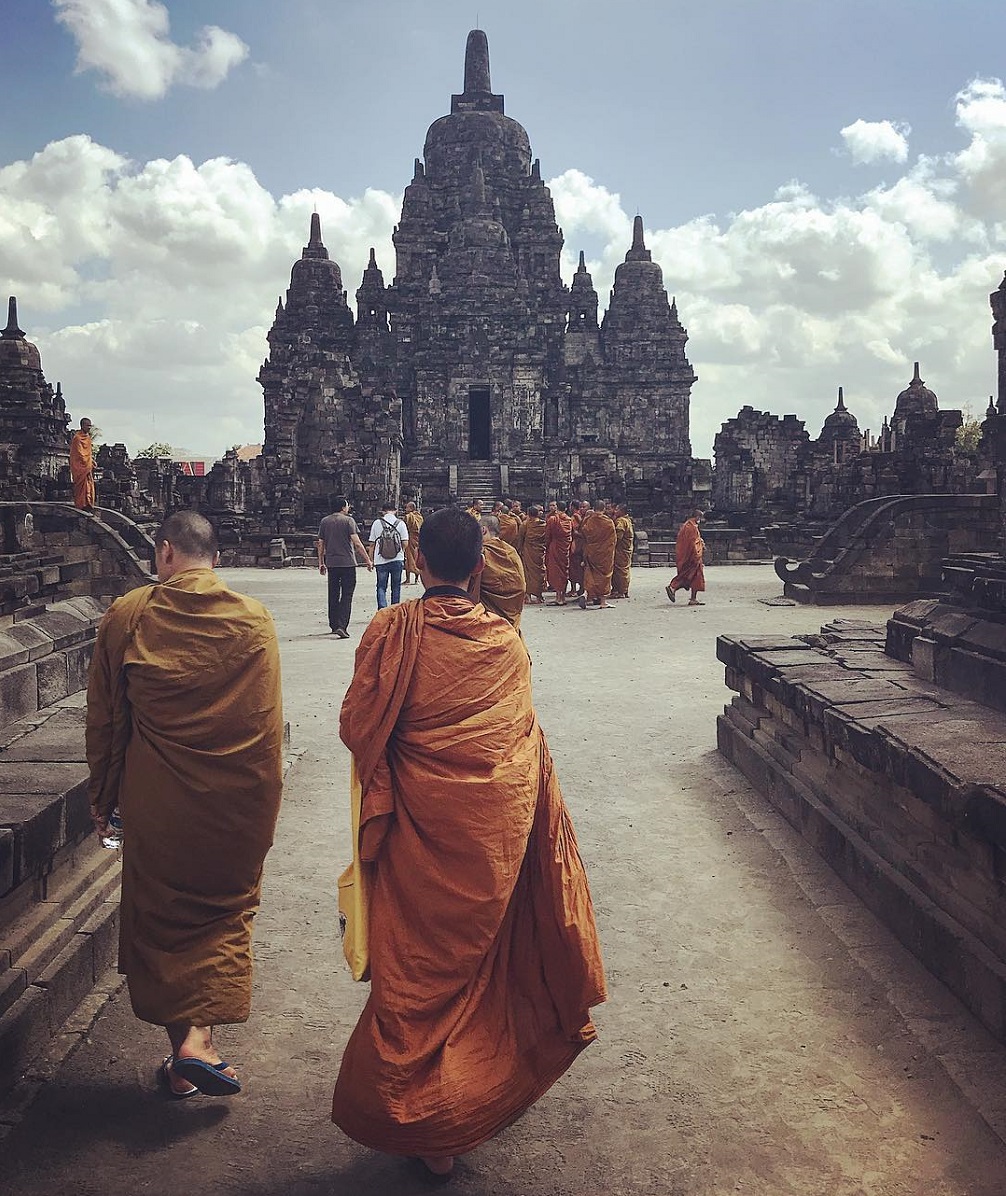
Monks in Candi Sewu
There may be many Buddhas, but only one Dharmakaya. This Dharmakaya is identical with Adi Buddha. The sources of this Trikaya doctrine are the Avatamsaka sūtra and Mahāyāna śraddhotpādaśāstra, the work of Asvagosha. Although revered, prayers are never addressed to Adi Buddha. With his power, he emanates into five Dhyani Buddhas.
The concept of Ādi Buddha is also closely related to Srikāla-cakra-tantra, a Shaivite tantra of the 10th or 11th century AD. But the term Ādi Buddha had first appeared in Nāmasangiti as the epithet of Mañjusri.
The other scriptures mentioning Adi-Buddha are the Svayambhu Purana, Tattvasamgraha sūtra and Guhyasamāja sūtra.
The Indonesian scriptures which contains the name of Sanghyang Adi Buddha are:
- Guna Karanda Vyuha – “In the time of nothingness, Shambu was already exist, this is what is called Svayambhu (self-manifested), and preceded all things, this is why he is called the Adi Buddha.”
- Sanghyang Kamahayanikan from the Mpu Sindok era – “All praises for Sanghyang Adi Buddha, this is the Sanghyang Kamahayanikan that I have been wanted to teach you, to the sons of Buddha (whom also) the family of Tathagata, the grandeur of ‘Sanghyang Mahayana’ practices is what i have to teach you.”
- Namasangiti of Candrakirti from Srivijaya
The evidence for a belief in Adi-Buddha is also evidenced by the symbolism of Borobudur’s final stupa. Inside that stupa once was an incomplete and rough Buddha statue which is depicting the Adi Buddha which is unimaginable by humans. This is seen as proof that theistic Buddhism was present in Java since at least the 8th century.
Indonesian Buddhayana followers use the greeting Namo Sanghyang Adi Buddhaya. The complete salutation which is commonly used as a greeting in the books’ preface, letters, or meetings is:
Namo Sanghyang Adi Buddhaya
Namo Buddhaya, Bodhisatvaya Mahasatvaya
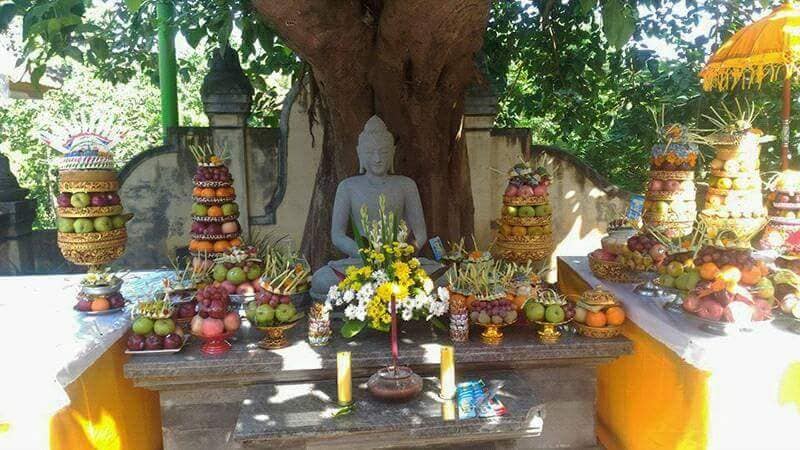
☸ Modern Indonesian Buddhayana
Today, the complete Indonesian Buddhist teachings can be found in Buddhayana, a syncretism between Vajrayana, Mahayana and Theravada, as a continuation of the 2000-years old syncretic Indonesian Buddhist tradition. Buddhayana was established by the Venerable Ashin Jinarakkhita after Indonesian independence.
The revival of Buddhism in Indonesia is symbolically dated back at the Waisak ceremony in Borobudur in 1953 for the first time in several centuries. Three years later in 1956, the Buddhist world commemorated Buddha Jayanti, 2500 years since the passing away of Buddha Gautama (Mahaparinibbana).
Ashin Jinarakkhita energetically worked for the reestablishment of Buddhist temples and monasteries. From an early age, his interest in spirituality had encouraged him to become an anagarika – a homeless follower of the teaching of Buddha. He had a good friendship with Kwee Tek Hoay, the founder of Tri Dharma (a unified creed from the three Chinese religions: Buddhism, Confucianism and Taoism).
He ordained his bikkhu in both the Theravada tradition and Mahayana tradition. As a clear symbol, he both dressed in the Theravadan style while letting his beard grow like the Chinese Buddhists. In short, he represented himself as the amalgamation of the Theravada and Mahayana traditions.
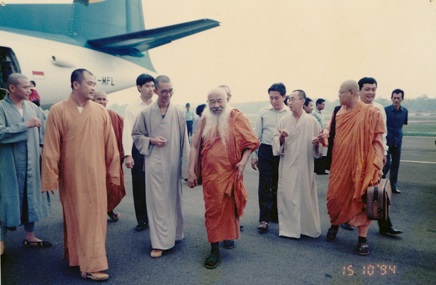
He also learned and practiced Kejawen, the Javanese religion, in order to assimilate elements of Javanese mysticism. Ashin Jinarakkhita established the Perbuddhi organization with several Javanese Buddhists and through this, he developed the syncretic Buddhayana lineage in the 1950s and 1960s. It taught the union of both Theravada, Mahayana, Tantrayana Buddhism, as well as the Kejawen cultural roots and syncretic Chinese religion.
Through Buddhayana, Ashin Jinarakkhita re-established the monotheist concept of Sang Hyang Adi Buddha in Indonesia, that was rooted in Old Javanese Buddhist texts such as the Sang Hyang Kamahayanikan.
Post Soekarno’s government in 1965, there was a huge changing in Indonesia’s politics. The massacre of millions of suspected Communists in 1965 had impacted the Chinese life and traditions. The Soeharto government had assimilated the Communist party with atheism and required all citizens to register with an official religion.
To do so, all religions were measured by the standards of the Abrahamic religions, meaning that any belief system must show a theistic belief, a prophet and a holy book.
Therefore, to unite the various branches of Buddhism in Indonesia, Bhikkhu Ashin Jinarakkhita reintroduced two ancient, unifying concepts:
- that all branches of Buddhism are compatible – united in Buddhayana
- that Indonesian Buddhism is also theistic, by re-establishing the theistic concept of Sang Hyang Adi Buddha
- established the national unity of all ethnic divisions of Indonesian Buddhism under a single denomination. Being Indonesian, must throw away their original tradition even with name and language.
Through Buddhayana, Bhikkhu Ashin Jinarakkhita developed of Buddhism in wider perspective beyond the denomination and cultural boundaries. The Buddhayana school had unified all Buddha traditions, in a truly Indonesian spirit of syncretism.
The Buddhayana movement also influenced the Chinese Buddhists to not only visit the Klenteng (Chinese Buddhist temples) to burn incense, light candles and ask for boons, but also to learn and conduct the Buddhist teachings. Meanwhile, some Indonesian-Chinese maintain their own syncretic tradition called Tri Dharma that merges Buddhism, Confucianism and Taoism.
